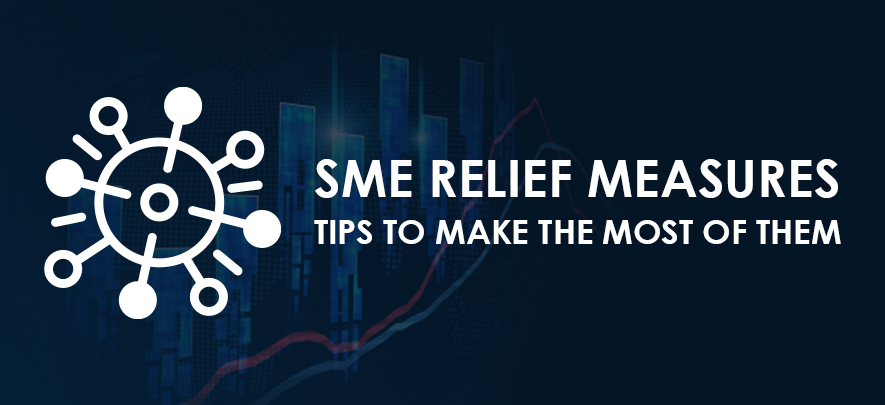With COVID-19’s devastating impact on the economies, governments around the world have started offering the much-needed relief measures to support SMEs. Being part of a large international Bank during the 2008 financial crisis gave me the opportunity to oversee the Bank’s portfolios across countries that participated in SME Support Programmes. Hence, sharing some useful tips for the enterprising SME community as you avail the relief measures and propel the economy as you have always done.
In 2008, the financial crisis was a lot about Banks being short on capital and liquidity and hence slowing down on new credit facilities and pulling back existing lines. Neither the impact of financial crisis was so widespread, nor did economies come to a near grinding halt. The impact of COVID-19 is more direct and severe on SMEs. Hence, I would expect more support directly benefiting SMEs, it will be more than just getting the Banks to lend more to SMEs.
- Expect the relief measures to come in phases over a period of time as the situation evolves. Some will be reinforcement or modification of existing programmes, but majority will be special programmes designed specifically for SMEs to withstand the impact of Covid-19.
- The initial set of relief measures (already underway in some countries) will focus on supporting the SMEs to stay afloat. The typical support measures will include moratorium on interest and loan repayments, deferment or rebate of tax payments, wage subsidies, specific purpose loans (e.g. to pay employees) at a subsidized rate or guaranteed i.e. lenders will not bear the risk (either entirely or partially) of the SME defaulting.
- The next set of support programmes will likely focus on reviving the economic activity with measures to encourage spending. For example, supporting SMEs working capital and business expansion plans such as employing more people, installing new equipment, expanding to new geographies, adding a new product line, stocking more inventory to boost sales, etc. Generally, SMEs would have deferred these given poor business sentiments.
- Despite the above measures, inevitably there will be business closures and it’s likely that in the near future, the number of businesses closed will exceed new establishments. Hence the third phase (if any) will be more focused on programmes to support start-ups in specific sectors or locations which were most impacted.
- While majority of relief measures will be monetary i.e. help SMEs with their cashflows; there will be other relief measures giving SMEs more time to meet statutory obligations or focused on getting SMEs better prepared(e.g. training or digital services at subsidized cost).
- The role of the Banks with the initial programmes will likely be to facilitate the outreach of the financial relief measures to SMEs and process it on behalf of government agencies. While the processes of the Banks will certainly be tested, there is lot of value for SMEs to stick to their existing Banks. In instances where relief measures are related to existing facilities, the only way to avail it will be through the existing Bank.
- SMEs should look out for the following as they avail the relief measures:
- Keep an eye on the relief programs for your country through your RM, Bank’s websites or Government websites, media platforms including aggregator platforms.
- Not all programs will be mandatory for all Banks to participate. Also, certain category of lenders may not be eligible to participate. Hence, check before availing any new financial product or renewing an existing facility for better options under relief measures.
- Check if it’s an Opt-in vs Opt-out? Most programmes will require SMEs to submit specific applications to qualify.
- A moratorium on interest payment or instalment does not mean interest is waived or subsidized unless explicitly stated. While it will ease cash flows, the interest cost is still there. Hence, SMEs with multiple facilities, use the option selectively weighing in the borrowing cost versus liquidity.
- As most relief programs will have a maximum program size, do not take if you don’t need, as this may deny someone else the opportunity. At the same time, apply early if you really need it.
- There could be an opportunity to lower the borrowing cost of existing facilities by availing pricing subsidies. If you choose to do so by refinancing, ensure there is no program restriction on the use of funds for repaying existing loans.
- The same support program may be offered by multiple banks with a maximum borrowing limit for a SME by each Bank. There likely will also be a maximum limit on the aggregated facility a SME can avail across multiple Banks.
- The typical qualification criteria for the programs will be around the definition of SME (based on annual turnover or number of employees), business to be operational as of a cut-off date, not severely delinquent (e.g. 2 or 3 payments overdue) and use of funds in line with the objective of the programme.
- Some of the other noticeable trends will be a drop in Credit Scoring or Credit Grades across the board for most SMEs. Most scorecards for businesses comprise of factors related to business activity. In general, Banks will be cautious but at the same time will expect and accommodate a certain level of drop in the scorecard. Hence, there should not be a reduction in credit lines or increase in pricing as SMEs renew their existing facilities.
These are challenging times, hope SMEs make the best use of the relief measures as they become available, navigate the crisis with resilience and emerge the post-corona era safe and sound.
Also read: An unprecedented challenge, also an opportunity for SMEs to do unprecedented things
To explore business opportunities, link with me by clicking on the 'Connect' button on my eBiz Card.
Disclaimer: The views and opinions expressed in this article are those of the author and do not necessarily reflect the views, official policy or position of GlobalLinker.
Posted by
Satyam Agrawal
Responsible for driving the growth of the Platform in ASEAN Markets and embedding Financial Solutions into the Platform globally.





Comments (4)
Share this content
Please login or Register to join the discussion